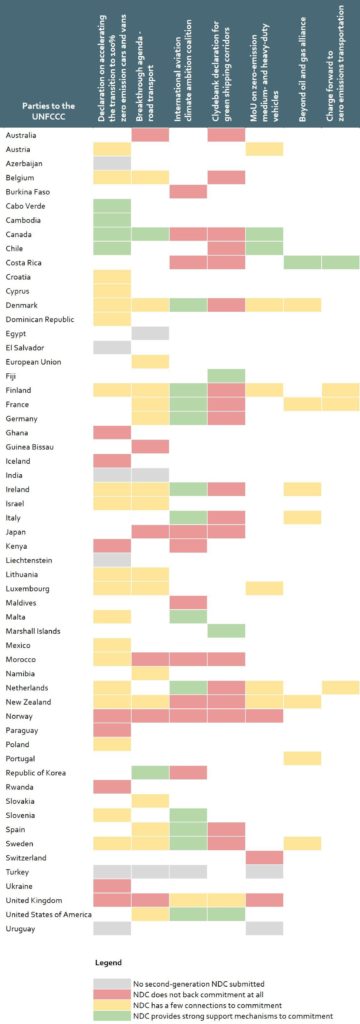7 December 2021 In Adaptation, Advocacy and Engagement, Blog Post, Climate Change, Dialogue and Networking, Global, Mitigation, Morning Commute Blog, News, Report, Paper or Issue Brief, Sustainable Development
Preliminary Analysis of Coherence Between Commitments and Initiatives Launched at COP26 and the NDCs of Signatory Countries
Are Nationally Determined Contributions (NDCs) aligned with the commitments and initiatives on transport announced on the occasion of COP26? The SLOCAT Secretariat has cross-referenced transport commitments and initiatives announced at COP26 with the new NDCs submitted by countries which signed up to the initiatives. A preliminary analysis shows that overall the NDCs of signatory countries are not aligned with the initiatives they have signed up to.

- Only four (Burkina Faso, Fiji, Israel, and Japan) of the countries which signed up to at least one of the commitments have included specific transport GHG targets in their second-generation NDCs (out of 18 countries with such a target) (SLOCAT Climate Strategies for Transport).
- International Aviation Climate Ambition Coalition: The strongest alignment can be seen for this declaration. Several NDCs express their intention to engage with ICAO or to tackle aviation emissions (in some cases it might be limited to domestic aviation emissions).
- Clyde Declaration for Green Shipping Corridors: Fiji, the Marshall Islands and the United States of America are the only signatories of this declaration with mechanisms in their NDCs to support the delivery of maritime transport decarbonisation.
- Commitments and initiatives related to zero-emission vehicles: There are weak connections to the second-generation NDCs of signatory countries. Cabo Verde, Cambodia, Canada and Chile stated strong e-mobility ambitions in their NDCs, while the EU emphasised a clean vehicle fleet. However, it is worth noting that many of the countries signatories had already announced or publicly discussed targets to phase out fossil fuel-powered cars in previous years; some of them even with more ambitious targets (SLOCAT’s e-mobility overview). For example, Norway plans to ban sales of diesel and gasoline cars by 2025, Denmark, Israel, Netherlands, Slovenia, Sweden and the UK by 2030, Cabo Verde by 2035, Canada, France and Portugal by 2040.
Some additional open questions, across all the commitments and initiatives:
- To contribute to the goals of the Paris Agreement, it is essential that commitments and initiatives are supported by actual domestic targets set in national policies and regulations (Transport & Environment). Are the commitments sufficient to transition road transport, maritime transport and aviation towards a sustained decarbonisation pathway in line with the 1.5ºC target of the Paris Agreement? To what extent do these commitments and initiatives signal a long-term determination to increase attention to climate action in transport policy?
- Countries should revisit in 2022 their NDC adaptation and mitigation actions for increased overall ambition, in coherence to the commitments and initiatives they have signed up to. Will this happen? What will be the UNFCCC mechanism to encourage positive mutually-reinforcing cross-fertilisation between these commitments and any eventual NDC updates in 2022?
- Will there be efforts to expand the number of signatories and if so, spearheaded by whom? What will be the UNFCCC mechanism to monitor and assess the actual implementation and impact of these commitments over time?
- The commitments focus on major polluting transport sectors (road transport, aviation and shipping) but they lack the support to public transport, rail, cycling and walking among others. A more balanced approach that goes beyond technologies would ensure greater impacts. Remarks recognising the need to support holistic approaches to transport systems, including active travel, public transport and shared mobility, were added last-minute to the UK COP26 Presidency-led Declaration on Accelerating the Transition to 100% Zero Emission Cars and Vans, following the strong mobilisation by stakeholders. Will COP27 and future COPs enable the development of commitments promoting public transport, walking, cycling and shared mobility? And the role in tackling climate change of “avoiding” unnecessary motorised transport – while ensuring access to transport and socio-economic opportunities? E.g. local economy, circular economy, 3D printing, proximity-based urban and transport planning, in-home services, video conferencing, car-free lifestyles, etc.
- Is there enough attention to transforming supply chains to ensure corporate net zero ambition can be delivered across the globe?
SLOCAT Knowledge Products SLOCAT Transport and Climate Change Global Status Report – 2nd Edition, particularly Section 3.1: National Policy Frameworks for Transport and Climate Change. SLOCAT overview of e-mobility trends and targets: Tracker of publicly announced e-mobility targets of countries, regions, cities, companies and major automobile manufacturers. |
Methodology and limitations of this preliminary SLOCAT analysis: The overall intention of the transport commitment and initiative has been compared to transport actions and targets in the NDC of the signatory country. The content of the NDCs was compared to the overall scope of the commitment. The existence of mentions to the topic of each commitment and initiative (zero emission vehicle, maritime transport, aviation and fossil fuel phase-out) in the NDC was examined. Data on the NDCs was obtained from the SLOCAT and GIZ’s Tracker of Climate Strategies for Transport. Findings were grouped in the three categories (see legend on the bottom of the figure). The analysis used the second-generation NDCs as the main reference. The EU submitted a NDC on behalf of its member states, thus the scoring results are the same for every EU member. Countries might state their support to commitments in other strategies (for example, national transport strategies or long-term low greenhouse gas emission development strategies) or already have mechanisms in place to implement the goals of commitments. Only transport commitments and initiatives with country signatories have been included. As shown earlier in this report, cities, regions and states, as well as companies and international initiatives are among the signatories of these commitments and initiatives.They have been omitted for the purpose of this preliminary analysis due to the complexity of identifying for them a framework strategy equivalent to a country’s NDC. |